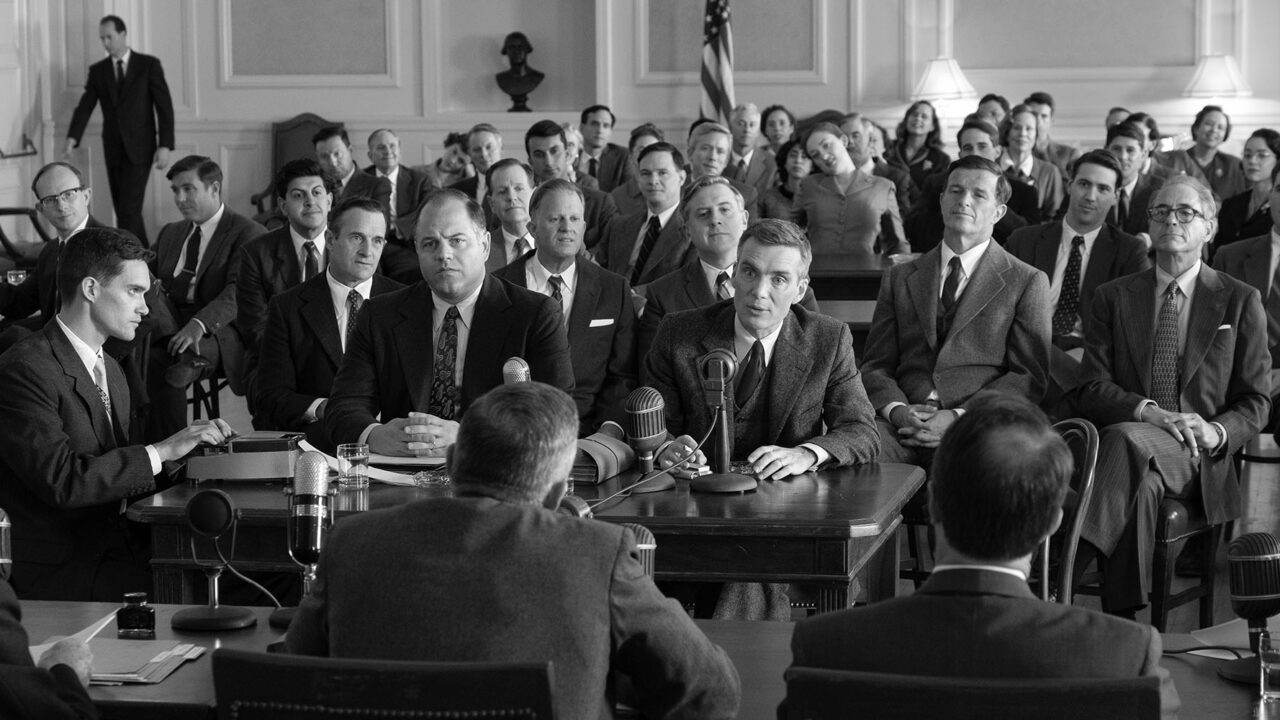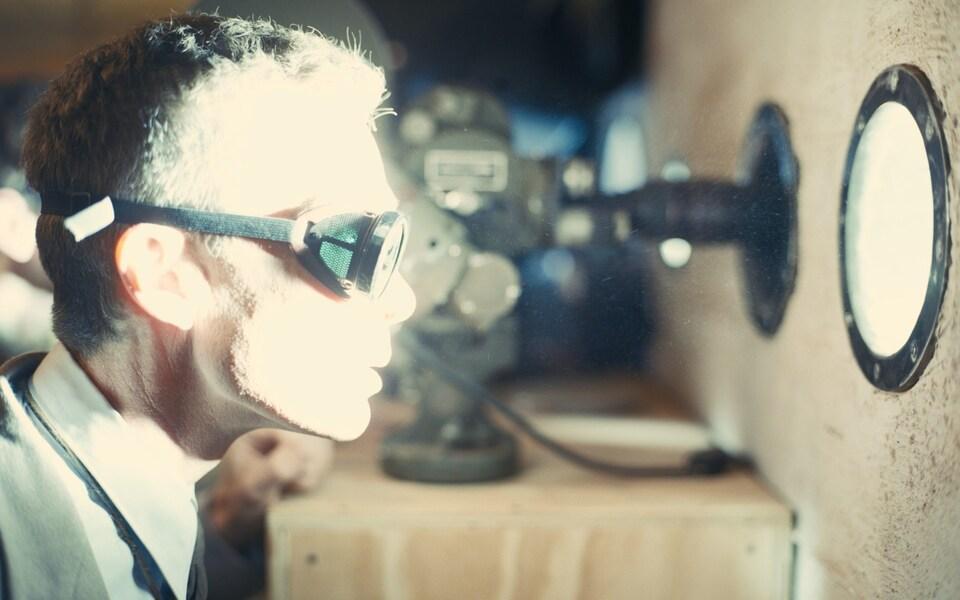Christopher Nolan’s Plea, ‘Round About Midnight
“Oppenheimer” is an intimate, cautionary tale about the misery and the power of nuclear weapons. Image: Universal Pictures
Image: Universal Pictures
Over the last decade, Christopher Nolan’s signature elevated pulp — once the domain of Bat-men, dream-thieves and dueling stage magicians — has begun to feature morose real-world realizations, from the climate emergency and grain-killing blight of “Interstellar,” to the temporal assassins in “Tenet,” who Nolan imagines have suffered so much at the hands of war and climate change that they’re left with no choice but to turn back the clock. His latest, the World War II biopic, “Oppenheimer,” plays like a culmination of his long-standing aesthetic fixations and more recent thematic anxieties.
Bucking the cradle-to-grave structure of most traditional Hollywood biopics, Nolan tells the story of J. Robert Oppenheimer, father of the atomic bomb, in splintered fashion. He splits his timelines prismatically between two government hearings — that of Oppenheimer (Cillian Murphy) and his ally turned political adversary Lewis Strauss (Robert Downey Jr.). He uses this framework to reveal earlier events and time periods as recalled by both men. Even as their memories unfold more or less chronologically, the film’s first hour feels free-form, with scenes portraying a series of key historical events, such as Oppenheimer’s introduction to fellow physicist Ernest Lawrence (Josh Hartnett). Once the gist of each meeting becomes clear, the edit skips forward with purpose, like a stone across water, building toward the film’s defining historical event, the outbreak of World War II and the start of the race to develop the atom bomb before the Nazis.
This initial frantic pacing reflects what, by Oppenheimer’s own admission, is a troubled mind and constant state of emotional malaise. The audience is granted a peek into his psyche that is not afforded other characters. His frequent fits of apocalyptic anxieties — premonitory visions of unstable subatomic particles unleashing hellfire on humanity — burst to life and envelope the screen. These awe-inspiring visions of the fearsome ground the movie, and prevent it from feeling disjointed despite its breakneck editing. After he develops the bomb, this volatility is transposed onto the real world in each of his interactions with the prototype. Every time it is touched, tinkered with or transported, we inhabit Oppenheimer’s fear that the slightest movement could set it alight and destroy the world.
Every time it is touched, tinkered with or transported, we inhabit Oppenheimer’s fear that the slightest movement could set it alight and destroy the world.
After the bomb is first tested on July 16, 1945, the famous Trinity Test — a scene whose enormous scale is matched only by its gut-shaking impact — the sense of unpredictability becomes lodged between the physical world and Oppenheimer’s psyche. Having witnessed the power of the exploded atom first hand, his visions are no longer contained to the abstract. Once the bomb is dropped on Hiroshima, on August 6, his waking moments are plagued by horrifying premonitions of destruction, including the instant deaths of those around him. Editor Jennifer Lame lures us into these intrusive thoughts through stimuli of light and sound. Feet stomping in celebration begin to sound like thundering explosions. Laughs and smiles resemble anguished screams. The very atmosphere around Oppenheimer shakes and vibrates like a volatile substance. Everything in his vicinity becomes a reminder of what he has unleashed. It’s a trick Nolan has used before, beginning with “Memento,” courtesy of Nolan’s long-time collaborator, the Oscar-winning editor Lee Smith.
Where “Oppenheimer” stands apart from these films is the lack of separation between what the triggers interrupt and where they lead. The difference between dream and waking, past and present, is gossamer. Oppenheimer’s visions become terrifying manifestations of the world he has brought into being, where the horrors of nuclear war have gone in a blinding flash from abstract to horrifyingly real. When he envisions the effects of the working bomb, the only time a human A-bomb victim is depicted, the camera falls on an anonymous young woman whose skin, he imagines, is peeled away by flash heat. The actress playing this character is Christopher Nolan’s own real-life daughter, 22-year-old Flora Nolan.
Flora was born in 2001, shortly after which Nolan embarked on his first big-budget studio production, “Batman Begins.” In films like “The Prestige” and “Inception,” he has depicted fathers on obsessive quests eventually finding their way back to their children, as if Nolan were lamenting time spent away from his family while making globe-trotting blockbusters. The last time Nolan’s daughter appeared in one of his films was “Interstellar,” when the adult Murphy (Jessica Chastain) meets her younger self’s gaze as her family evacuates their dust-storm-ravaged home. It was a moment of fiction and reality colliding. Murphy herself can be read as a stand-in for Flora, since the film is about a father, Cooper (Matthew McConaughey), leaving his daughter behind.
“Interstellar”’s conception of this dynamic is abstract: its gravity-warping time slippage sees Cooper spend hours on other planets while his daughter ages years. This is not unlike the time Nolan spends on set, taking months to capture mere minutes of footage. But for Nolan to bring his own daughter into the equation suggests that the movieis more than another filmic apology for time spent away. The melting of his own daughter’s flesh in the heat of an atom bomb suggests a father’s profound fears about the world he will leave behind.
Oppenheimer’s visions become terrifying manifestations of the world he has brought into being, where the horrors of nuclear war have gone in a blinding flash from abstract to horrifyingly real.
Our collective existence continues to rest on the knife’s edge of nuclear conflagration made possibly by Oppenheimer’s work at Los Alamos. The Bulletin of Atomic Scientists reminds us how sharp that edge really is: the Doomsday Clock now stands at 90 seconds to midnight, the closest it has ever been. Nuclear risk, climate change, biological threats and disruptive technologies have pushed humanity into what the Bulletin terms “unprecedented danger.”
In his later life, Oppenheimer opposed the continuation of atomic testing and stockpiling, and spoke out against the development of the hydrogen bomb. This is a perspective with which Nolan seems to align. But the scientist’s postwar politics were not an absolution, and he continues to suffer. In “Oppenheimer,” the title character’s regrets do not dissipate; they fester. His premonitions become his permanent punishment.
While Nolan’s recent oeuvre deals with various scenarios that threaten the planet, his movies also suggest that the genie can be put back in the bottle, at least to some degree, through radical climate action or orderly nuclear disarmament. “Oppenheimer” is a plea for the latter on two fronts. It depicts the horrifying misery that nuclear weapons promise to unleash on our loved ones — and on civilization itself, leaving a lifeless, irradiated planet with billions starved by nuclear winter — and asks us to consider the damage to our souls caused by our reliance on the threat of this misery.

Nolan conveys Oppenheimer’s guilt through the physicist’s perpetually haunted expression, as well as an encounter he has during a party at the Manhattan Project’s Los Alamos headquarters, where scientists and soldiers are celebrating the bombing of Hiroshima. What, after all, is there to celebrate? The journalist John Hersey described the scene at Hiroshima in his book of the same name:
Mr. Tanimoto found about twenty men and women on the sandspit. He drove the boat onto the bank and urged them to get aboard. They did not move and he realized that they were too weak to lift themselves. He reached down and took a woman by the hands, but her skin slipped off in huge, glove-like pieces… He lifted the slimy living bodies out and carried them up the slope away from the tide. He had to keep consciously repeating to himself, “These are human beings.”
In the film, Oppenheimer is strolling in a daze following the bombing of Hiroshima when he witnesses a distraught fellow physicist, Seth Neddemeyer (Devon Bostick), keeled over, his nose and mouth running with vomit and snot, almost to the point of choking, as if the overpowering guilt of his actions could no longer be contained. It’s a sickening image of how one’s conscience might contort after unleashing and justifying suffering on such a scale.
History continues to debate whether to celebrate or condemn Oppenheimer and his team, but the man himself was forced to live with the weight of his creation, like Prometheus, whose myth gave the biography the film is based on its name. The Greek legend tells of a man chained to a rock as his insides are devoured without end by birds of prey, his punishment for harnessing the fire of the gods. The film’s big question is whether anyone deserves such a waking hell. The world could end at any moment, but for Nolan’s Oppenheimer, it ended the day of the Trinity Test, and again on every day after.
Your support matters…Independent journalism is under threat and overshadowed by heavily funded mainstream media.
You can help level the playing field. Become a member.
Your tax-deductible contribution keeps us digging beneath the headlines to give you thought-provoking, investigative reporting and analysis that unearths what's really happening- without compromise.
Give today to support our courageous, independent journalists.
You need to be a supporter to comment.
There are currently no responses to this article.
Be the first to respond.